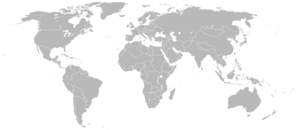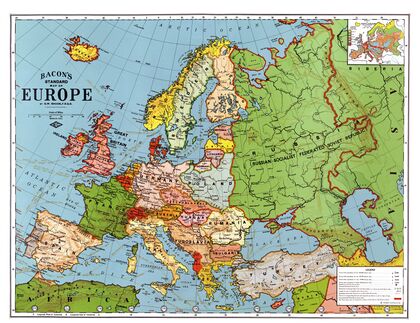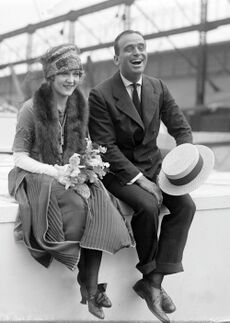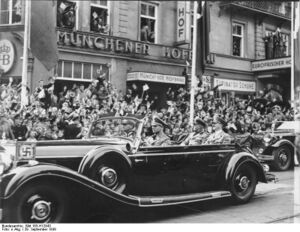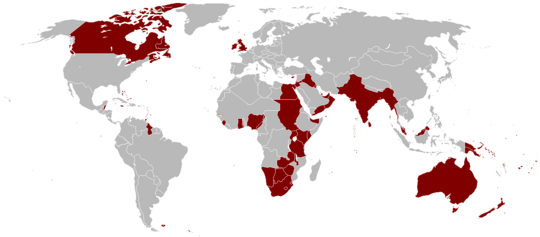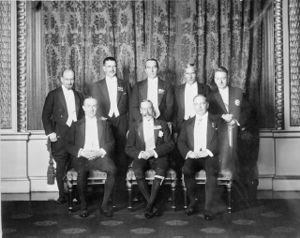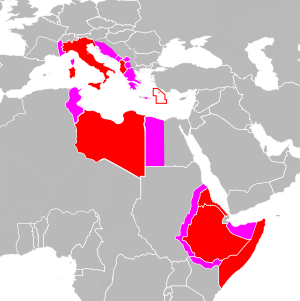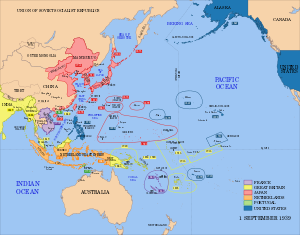فترة ما بين الحربين العالميتين
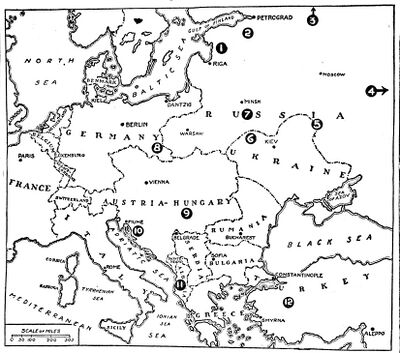
- حرب استقلال دول البلطيق والحرب الأهلية الروسية
- الجيش الأبيض لـيودنتش
- تدخل شمال روسيا
- الجيش الأبيض لـكولتشاك: سيبيريا
- دنيكين: الجيش الأبيض
- پتليورا: الإدارة الأوكرانية
- الحرب الپولندية السوڤيتية
- توتر سيليزيا بين الپولنديين والألمان.
- الاحتلال الروماني للمجر
- گابرييلى دانونزيو يستولي على فيومى، وينشئ وصاية كرنارو الإيطالية
- القتال النزق في ألبانيا
- حرب الاستقلال التركية
الفترة ما بين الحربين العالميتين في سياق تاريخ القرن العشرين هي الفترة بين نهاية الحرب العالمية الأولى في نوفمبر 1918 وبداية الحرب العالمية الثانية في سبتمبر 1939. بالرغم من أنها فترة قصيرة نسبيا من الزمن إلا أنها مثلت حقبة من التغييرات الهامة في جميع أنحاء العالم. توسع النفط والميكنة المرتبطة بها بشكل كبير مما سميت بالعشرينات الهادرة (والعشرينات السعيدة (en)[2])، وهي فترة ازدهار اقتصادي ونمو الطبقة الوسطى في أمريكا الشمالية وأوروبا وأجزاء أخرى كثيرة من العالم. أصبحت السيارات والإضاءة الكهربائية والبث الإذاعي وأكثر شيوعًا بين السكان في العالم المتقدم. ولكن أعقب تلك الحقبة فترة الكساد العظيم، وهي حالة انكماش اقتصادي عالمي لم يسبق لها مثيل وألحقت أضرارًا بالغة بالعديد من أكبر الاقتصادات في العالم.
سياسياً تزامن مع هذه الحقبة صعود الشيوعية بدءاً من روسيا مع ثورة أكتوبر بعد انتهاء الحرب العالمية الأولى، وانتهاءا بظهور الفاشية خاصة في ألمانيا وإيطاليا. أما الصين فقد كانت في فترة طويلة من عدم الاستقرار والحرب الأهلية بين حزب الكومينتانغ والحزب الشيوعي الصيني. واجهت العديد من الإمبراطوريات مثل البريطانية والفرنسية تحديات صعبة، حيث كان النظرة إلى الإمبريالية في أوروبا سلبية بازدياد، واكتسبت حركات الاستقلال في الهند البريطانية والهند الصينية الفرنسية وأيرلندا ومناطق أخرى زخما.
تفككت في تلك الفترة كلا من الدولة العثمانية وإمبراطورية النمسا المجر والألمانية. أعيد توزيع المستعمرات العثمانية والأمبراطورية الألمانية بين الحلفاء. انفصل أقصى الجزء الغربي من الإمبراطورية الروسية: استونيا وفنلندا ولاتفيا ولتوانيا وبولندا وأصبحت دولًا مستقلة، بينما اختارت بسارابيا (جمهورية مولدوفا) إعادة الوحدة مع رومانيا.
تمكن الشيوعيون في اتحاد الجمهوريات الاشتراكية السوفياتية من استعادة السيطرة على أوكرانيا وأرمينيا وأذربيجان وجورجيا. وقسمت أيرلندا مع كون الجزء الأكبر مستقلاً عن بريطانيا. وفي الشرق الأوسط حصلت مصر والعراق على استقلالهما. وخلال فترة الكساد الكبير قامت دول أمريكا اللاتينية بتأميم العديد من الشركات الأجنبية (خاصة الأمريكية) في محاولة لتعزيز اقتصاداتها المحلية. أدت الطموحات الإقليمية اليابانية والألمانية والإيطالية والسوڤيتية إلى توسع تلك الإمبراطوريات مما مهد الطريق إلى الحرب العالمية اللاحقة.
يعتبر الغزو الألماني والسوفيتي على بولندا في سبتمبر 1939 بداية الحرب العالمية الثانية ونهاية فترة ما بين الحربين.[3]
اضطراب في أوروپا
Following the Armistice of Compiègne on 11 November 1918 that ended World War I, the years 1918–1924 were marked by turmoil as the Russian Civil War continued to rage on, and Eastern Europe struggled to recover from the devastation of the First World War and the destabilising effects of not just the collapse of the Russian Empire, but the destruction of the German Empire, the Austro-Hungarian Empire, and the Ottoman Empire, as well. There were numerous new or restored countries in Southern, Central and Eastern Europe, some small in size, such as Lithuania or Latvia, and some larger, such as Poland and the Kingdom of Serbs, Croats, and Slovenes. The United States gained dominance in world finance. Thus, when Germany could no longer afford war reparations to Britain, France and other former members of the Entente, the Americans came up with the Dawes Plan and Wall Street invested heavily in Germany, which repaid its reparations to nations that, in turn, used the dollars to pay off their war debts to Washington. By the middle of the decade, prosperity was widespread, with the second half of the decade known as the Roaring Twenties.[4]
العلاقات الدولية
The important stages of interwar diplomacy and international relations included resolutions of wartime issues, such as reparations owed by Germany and boundaries; American involvement in European finances and disarmament projects; the expectations and failures of the League of Nations;[5] the relationships of the new countries to the old; the distrustful relations of the Soviet Union to the capitalist world; peace and disarmament efforts; responses to the Great Depression starting in 1929; the collapse of world trade; the collapse of democratic regimes one by one; the growth of efforts at economic autarky; Japanese aggressiveness toward China, occupying large amounts of Chinese land, as well as border disputes between the Soviet Union and Japan, leading to multiple clashes along the Soviet and Japanese occupied Manchurian border; Fascist diplomacy, including the aggressive moves by Mussolini's Italy and Hitler's Germany; the Spanish Civil War; Italy's invasion and occupation of Abyssinia (Ethiopia) in the Horn of Africa; the appeasement of Germany's expansionist moves against the German-speaking nation of Austria, the region inhabited by ethnic Germans called the Sudetenland in Czechoslovakia, the remilitarisation of the League of Nations demilitarised zone of the German Rhineland region, and the last, desperate stages of rearmament as the Second World War increasingly loomed.[6]
Disarmament was a very popular public policy. However, the League of Nations played little role in this effort, with the United States and Britain taking the lead. U.S. Secretary of State Charles Evans Hughes sponsored the Washington Naval Conference of 1921 in determining how many capital ships each major country was allowed. The new allocations were actually followed and there were no naval races in the 1920s. Britain played a leading role in the 1927 Geneva Naval Conference and the 1930 London Conference that led to the London Naval Treaty, which added cruisers and submarines to the list of ship allocations. However the refusal of Japan, Germany, Italy and the USSR to go along with this led to the meaningless Second London Naval Treaty of 1936. Naval disarmament had collapsed and the issue became rearming for a war against Germany and Japan.[7][8]
العشرينات الهادرة
Roaring Twenties highlighted novel and highly visible social and cultural trends and innovations. These trends, made possible by sustained economic prosperity, were most visible in major cities like New York City, Chicago, Paris, Berlin, and London. The Jazz Age began and Art Deco peaked.[9][10] For women, knee-length skirts and dresses became socially acceptable, as did bobbed hair with a Marcel wave. The young women who pioneered these trends were called "flappers".[11] Not all was new: "normalcy" returned to politics in the wake of hyper-emotional wartime passions in the United States, France, and Germany.[12] The leftist revolutions in Finland, Poland, Germany, Austria, Hungary, and Spain were defeated by conservatives, but succeeded in Russia, which became the base for Soviet Communism and Marxism–Leninism.[13] In Italy the National Fascist Party came to power under Benito Mussolini after threatening a March on Rome in 1922.[14]
Most independent countries enacted women's suffrage in the interwar era, including Canada in 1917 (though Quebec held out longer), Britain in 1918, and the United States in 1920. There were a few major countries that held out until after the Second World War (such as France, Switzerland and Portugal).[15] Leslie Hume argues:
- The women's contribution to the war effort combined with failures of the previous systems' of Government made it more difficult than hitherto to maintain that women were, both by constitution and temperament, unfit to vote. If women could work in munitions factories, it seemed both ungrateful and illogical to deny them a place in the polling booth. But the vote was much more than simply a reward for war work; the point was that women's participation in the war helped to dispel the fears that surrounded women's entry into the public arena.[16]
In Europe, according to Derek Aldcroft and Steven Morewood, "Nearly all countries registered some economic progress in the 1920s and most of them managed to regain or surpass their pre-war income and production levels by the end of the decade." The Netherlands, Norway, Sweden, Switzerland, and Greece did especially well, while Eastern Europe did poorly, due to the First World War and Russian Civil War.[17] In advanced economies the prosperity reached middle class households and many in the working class with radio, automobiles, telephones, and electric lighting and appliances. There was unprecedented industrial growth, accelerated consumer demand and aspirations, and significant changes in lifestyle and culture. The media began to focus on celebrities, especially sports heroes and movie stars. Major cities built large sports stadiums for the fans, in addition to palatial cinemas. The mechanisation of agriculture continued apace, producing an expansion of output that lowered prices, and made many farm workers redundant. Often they moved to nearby industrial towns and cities.
الكساد الكبير
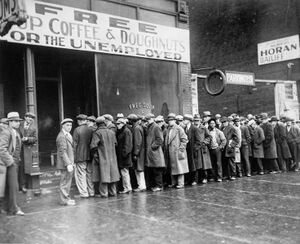
الفاشية تحل محل الديمقراطية
Democracy and prosperity largely went together in the 1920s. Economic disaster led to a distrust in the effectiveness of democracy and its collapse in much of Europe and Latin America, including the Baltic and Balkan countries, Poland, Spain, and Portugal. Powerful expansionary anti-democratic regimes emerged in Italy, Japan, and Germany.[18]
While communism was tightly contained in the isolated Soviet Union, fascism took control of the Kingdom of Italy in 1922; as the Great Depression worsened, Nazism emerged victorious in Germany, fascism spread to many other countries in Europe, and also played a major role in several countries in Latin America.[19] Fascist parties sprang up, attuned to local right-wing traditions, but also possessing common features that typically included extreme militaristic nationalism, a desire for economic self-containment, threats and aggression toward neighbouring countries, oppression of minorities, a ridicule of democracy while using its techniques to mobilise an angry middle-class base, and a disgust with cultural liberalism. Fascists believed in power, violence, male superiority, and a "natural" hierarchy, often led by dictators such as Benito Mussolini or Adolf Hitler. Fascism in power meant that liberalism and human rights were discarded, and individual pursuits and values were subordinated to what the party decided was best.[20]
الحرب الأهلية الاسبانية (1936–1939)
الإمبراطورية البريطانية
The changing world order that the war had brought about, in particular the growth of the United States and Japan as naval powers, and the rise of independence movements in India and Ireland, caused a major reassessment of British imperial policy.[21] Forced to choose between alignment with the United States or Japan, Britain opted not to renew the Anglo-Japanese Alliance and instead signed the 1922 Washington Naval Treaty, in which Britain accepted naval parity with the United States. The issue of the empire's security was a serious concern in Britain, as it was vital to the British pride, its finance, and its trade-oriented economy.[22][23]
India strongly supported the Empire in the First World War. It expected a reward, but failed to get sovereignty as the British Raj kept control in British hands and feared another rebellion like that of 1857. The Government of India Act 1919 failed to satisfy demand for independence. Mounting tension, particularly in the Punjab region, culminated in the Amritsar Massacre in 1919. Indian nationalism surged and centred in the Congress Party led by Mohandas Gandhi.[24] In Britain, public opinion was divided over the morality of the massacre between those who saw it as having saved India from anarchy and those who viewed it with revulsion.[25][26]
Egypt had been under de facto British control since the 1880s, despite its nominal ownership by the Ottoman Empire. In 1922, the Kingdom of Egypt was granted formal independence, though it continued to be a client state following British guidance. Egypt joined the League of Nations. Egypt's King Fuad and his son King Farouk and their conservative allies stayed in power with lavish lifestyles thanks to an informal alliance with Britain who would protect them from both secular and Muslim radicalism.[27] Mandatory Iraq, a British mandate since 1920, gained official independence as the Kingdom of Iraq in 1932 when King Faisal agreed to British terms of a military alliance and an assured flow of oil.[28][29]
In Palestine, Britain was presented with the problem of mediating between the Palestinian Arabs and increasing numbers of Jewish settlers. The Balfour Declaration, which had been incorporated into the terms of the mandate, stated that a national home for the Jewish people would be established in Palestine, and Jewish immigration allowed up to a limit that would be determined by the mandatory power. This led to increasing conflict with the Arab population, who openly revolted in 1936. As the threat of war with Germany increased during the 1930s, Britain judged the support of Arabs as more important than the establishment of a Jewish homeland, and shifted to a pro-Arab stance, limiting Jewish immigration and in turn triggering a Jewish insurgency.[26]
The Dominions (Canada, Newfoundland, Australia, New Zealand, South Africa and the Irish Free State) were self-governing and gained semi-independence in the World War, while Britain still controlled foreign policy and defence. The right of the Dominions to set their own foreign policy was recognised in 1923 and formalised by the 1931 Statute of Westminster. (Southern) Ireland effectively broke all ties with Britain in 1937, leaving the Commonwealth and becoming an independent republic.[26]
ألمانيا
جمهورية ڤايمار
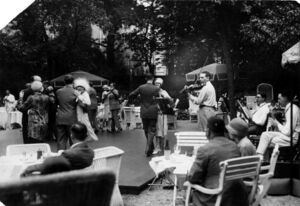
The humiliating peace terms in the Treaty of Versailles provoked bitter indignation throughout Germany, and seriously weakened the new democratic regime. The Treaty stripped Germany of all of its overseas colonies, of Alsace–Lorraine, and of predominantly Polish districts. The Allied armies occupied industrial sectors in western Germany including the Rhineland, and Germany was not allowed to have a real army, navy, or air force. Reparations were demanded, especially by France, involving shipments of raw materials, as well as annual payments.[30]
When Germany defaulted on its reparation payments, French and Belgian troops occupied the heavily industrialised Ruhr district (January 1923). The German government encouraged the population of the Ruhr to passive resistance: shops would not sell goods to the foreign soldiers, coal mines would not dig for the foreign troops, trams in which members of the occupation army had taken seat would be left abandoned in the middle of the street. The German government printed vast quantities of paper money, causing hyperinflation, which also damaged the French economy. The passive resistance proved effective, insofar as the occupation became a loss-making deal for the French government. But the hyperinflation caused many prudent savers to lose all the money they had saved. Weimar added new internal enemies every year, as anti-democratic Nazis, Nationalists, and Communists battled each other in the streets.[31]
Germany was the first state to establish diplomatic relations with the new Soviet Union. Under the Treaty of Rapallo, Germany accorded the Soviet Union de jure recognition, and the two signatories mutually agreed to cancel all pre-war debts and renounced war claims. In October 1925 the Treaty of Locarno was signed by Germany, France, Belgium, Britain, and Italy; it recognised Germany's borders with France and Belgium. Moreover, Britain, Italy, and Belgium undertook to assist France in the case that German troops marched into the demilitarised Rhineland. Locarno paved the way for Germany's admission to the League of Nations in 1926.[32]
العهد النازي 1933–1939
Hitler came to power in January 1933, and inaugurated an aggressive power designed to give Germany economic and political domination across central Europe. He did not attempt to recover the lost colonies. Until August 1939, the Nazis denounced Communists and the Soviet Union as the greatest enemy, along with the Jews.[33]
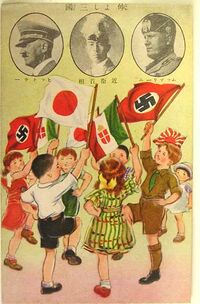
The humiliating peace terms in the Treaty of Versailles provoked bitter indignation throughout Germany, and seriously weakened the new democratic regime. The Treaty stripped Germany of all of its overseas colonies, of Alsace–Lorraine, and of predominantly Polish districts. The Allied armies occupied industrial sectors in western Germany including the Rhineland, and Germany was not allowed to have a real army, navy, or air force. Reparations were demanded, especially by France, involving shipments of raw materials, as well as annual payments.[34]
When Germany defaulted on its reparation payments, French and Belgian troops occupied the heavily industrialised Ruhr district (January 1923). The German government encouraged the population of the Ruhr to passive resistance: shops would not sell goods to the foreign soldiers, coal mines would not dig for the foreign troops, trams in which members of the occupation army had taken seat would be left abandoned in the middle of the street. The German government printed vast quantities of paper money, causing hyperinflation, which also damaged the French economy. The passive resistance proved effective, insofar as the occupation became a loss-making deal for the French government. But the hyperinflation caused many prudent savers to lose all the money they had saved. Weimar added new internal enemies every year, as anti-democratic Nazis, Nationalists, and Communists battled each other in the streets.[35]
Germany was the first state to establish diplomatic relations with the new Soviet Union. Under the Treaty of Rapallo, Germany accorded the Soviet Union de jure recognition, and the two signatories mutually agreed to cancel all pre-war debts and renounced war claims. In October 1925 the Treaty of Locarno was signed by Germany, France, Belgium, Britain, and Italy; it recognised Germany's borders with France and Belgium. Moreover, Britain, Italy, and Belgium undertook to assist France in the case that German troops marched into the demilitarised Rhineland. Locarno paved the way for Germany's admission to the League of Nations in 1926.[36]
إيطاليا
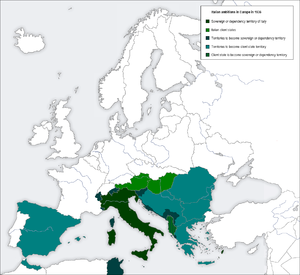
المفتاح:
In 1922, the leader of the Italian Fascist movement, Benito Mussolini, was appointed Prime Minister of Italy after the March on Rome. Mussolini resolved the question of sovereignty over the Dodecanese at the 1923 Treaty of Lausanne, which formalised Italian administration of both Libya and the Dodecanese Islands, in return for a payment to Turkey, the successor state to the Ottoman Empire, though he failed in an attempt to extract a mandate of a portion of Iraq from Britain.
The month following the ratification of the Treaty of Lausanne, Mussolini ordered the invasion of the Greek island of Corfu after the Corfu incident. The Italian press supported the move, noting that Corfu had been a Venetian possession for four hundred years. The matter was taken by Greece to the League of Nations, where Mussolini was convinced by Britain to evacuate Royal Italian Army troops, in return for reparations from Greece. The confrontation led Britain and Italy to resolve the question of Jubaland in 1924, which was merged into Italian Somaliland.[37]
During the late 1920s, imperial expansion became an increasingly favoured theme in Mussolini's speeches.[38] Amongst Mussolini's aims were that Italy had to become the dominant power in the Mediterranean that would be able to challenge France or Britain, as well as attain access to the Atlantic and Indian Oceans.[38] Mussolini alleged that Italy required uncontested access to the world's oceans and shipping lanes to ensure its national sovereignty.[39] This was elaborated on in a document he later drew up in 1939 called "The March to the Oceans", and included in the official records of a meeting of the Grand Council of Fascism.[39] This text asserted that maritime position determined a nation's independence: countries with free access to the high seas were independent; while those who lacked this, were not. Italy, which only had access to an inland sea without French and British acquiescence, was only a "semi-independent nation", and alleged to be a "prisoner in the Mediterranean":[39]
The bars of this prison are Corsica, Tunisia, Malta, and Cyprus. The guards of this prison are Gibraltar and Suez. Corsica is a pistol pointed at the heart of Italy; Tunisia at Sicily. Malta and Cyprus constitute a threat to all our positions in the eastern and western Mediterrean. Greece, Turkey, and Egypt have been ready to form a chain with Great Britain and to complete the politico-military encirclement of Italy. Thus Greece, Turkey, and Egypt must be considered vital enemies of Italy's expansion ... The aim of Italian policy, which cannot have, and does not have continental objectives of a European territorial nature except Albania, is first of all to break the bars of this prison ... Once the bars are broken, Italian policy can only have one motto—to march to the oceans.
— Benito Mussolini، The March to the Oceans[39]
In the Balkans, the Fascist regime claimed Dalmatia and held ambitions over Albania, Slovenia, Croatia, Bosnia and Herzegovina, Macedonia, and Greece based on the precedent of previous Roman dominance in these regions.[40] Dalmatia and Slovenia were to be directly annexed into Italy while the remainder of the Balkans was to be transformed into Italian client states.[41] The regime also sought to establish protective patron-client relationships with Austria, Hungary, Romania, and Bulgaria.[40]
In both 1932 and 1935, Italy demanded a League of Nations mandate of the former German Cameroon and a free hand in the Ethiopian Empire from France in return for Italian support against Germany in the Stresa Front.[42] This was refused by French Prime Minister Édouard Herriot, who was not yet sufficiently worried about the prospect of a German resurgence.[42] The failed resolution of the Abyssinia Crisis led to the Second Italo-Ethiopian War, in which Italy annexed Ethiopia to its empire.[بحاجة لمصدر]
Italy's stance towards Spain shifted between the 1920s and the 1930s. The Fascist regime in the 1920s held deep antagonism towards Spain due to Miguel Primo de Rivera's pro-French foreign policy. In 1926, Mussolini began aiding the Catalan separatist movement, which was led by Francesc Macià, against the Spanish government.[43] With the rise of the left-wing Republican government replacing the Spanish monarchy, Spanish monarchists and fascists repeatedly approached Italy for aid in overthrowing the Republican government, in which Italy agreed to support them to establish a pro-Italian government in Spain.[43] In July 1936, Francisco Franco of the Nationalist faction in the Spanish Civil War requested Italian support against the ruling Republican faction, and guaranteed that, if Italy supported the Nationalists, "future relations would be more than friendly" and that Italian support "would have permitted the influence of Rome to prevail over that of Berlin in the future politics of Spain".[44] Italy intervened in the civil war with the intention of occupying the Balearic Islands and creating a client state in Spain.[45] Italy sought the control of the Balearic Islands due to its strategic position—Italy could use the islands as a base to disrupt the lines of communication between France and its North African colonies and between British Gibraltar and Malta.[46] After the victory by Franco and the Nationalists in the war, Allied intelligence was informed that Italy was pressuring Spain to permit an Italian occupation of the Balearic Islands.[47]
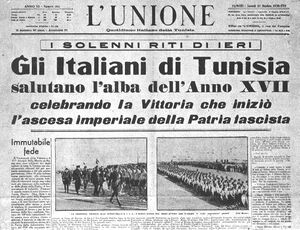
After Great Britain signed the Anglo-Italian Easter Accords in 1938, Mussolini and Foreign Minister Galeazzo Ciano issued demands for concessions in the Mediterranean by France, particularly regarding French Somaliland, Tunisia and the French-run Suez Canal.[48] Three weeks later, Mussolini told Ciano that he intended for an Italian takeover of Albania.[48] Mussolini professed that Italy would only be able to "breathe easily" if it had acquired a contiguous colonial domain in Africa from the Atlantic to the Indian Oceans, and when ten million Italians had settled in them.[38] In 1938, Italy demanded a sphere of influence in the Suez Canal in Egypt, specifically demanding that the French-dominated Suez Canal Company accept an Italian representative on its board of directors.[49] Italy opposed the French monopoly over the Suez Canal because, under the French-dominated Suez Canal Company, all merchant traffic to the Italian East Africa colony was forced to pay tolls on entering the canal.[49]
Albanian Prime Minister and President Ahmet Zogu, who had, in 1928, proclaimed himself King of Albania, failed to create a stable state.[50] Albanian society was deeply divided by religion and language, with a border dispute with Greece and an undeveloped, rural economy. In 1939, Italy invaded and annexed Albania as a separate kingdom in personal union with the Italian crown. Italy had long built strong links with the Albanian leadership and considered it firmly within its sphere of influence. Mussolini wanted a spectacular success over a smaller neighbour to match Germany's annexation of Austria and Czechoslovakia. Italian King Victor Emmanuel III took the Albanian crown, and a fascist government under Shefqet Vërlaci was established.[51]
To one degree or another, Spain had been unstable politically for centuries, and in 1936–1939 was wracked by one of the bloodiest civil wars of the 20th century. The real importance comes from outside countries. In Spain the conservative and Catholic elements and the army revolted against the newly elected government, and full-scale civil war erupted. Fascist Italy and Nazi Germany gave munitions and strong military units to the rebel Nationalists, led by General Francisco Franco. The Republican (or "Loyalist") government, was on the defensive, but it received significant help from the Soviet Union and Mexico. Led by Great Britain and France, and including the United States, most countries remained neutral and refused to provide armaments to either side. The powerful fear was that this localised conflict would escalate into a European conflagration that no one wanted.
أنماط إقليمية
البلقان
The Great Depression destabilised the Kingdom of Romania. The early 1930s were marked by social unrest, high unemployment, and strikes. In several instances, the Romanian government violently repressed strikes and riots, notably the 1929 miners' strike in Valea Jiului and the strike in the Grivița railroad workshops. In the mid-1930s, the Romanian economy recovered and the industry grew significantly, although about 80% of Romanians were still employed in agriculture. French economic and political influence was predominant in the early 1920s but then Germany became more dominant, especially in the 1930s.[52]
In the Albanian Kingdom, Zog I introduced new civil codes, constitutional changes and attempted land reforms, the latter which was largely unsuccessful due to the inadequacy of the country's banking system that could not deal with advanced reformist transactions. Albania's reliance on Italy also grew as Italians exercised control over nearly every Albanian official through money and patronage, breeding a colonial-like mentality.[53]
Ethnic integration and assimilation was a major problem faced by the newly formed post-World War I Balkan states, which were compounded by historical differences. In the Kingdom of Yugoslavia for instance, its most influential element was the pre-war Kingdom of Serbia but also integrated states like Slovenia and Croatia, which were part of Austria-Hungary. With new territories came varying legal systems, social structures and political structures. Social and economic development rates also varied as for example Slovenia and Croatia was far more advanced economically than Kosovo and Macedonia. Redistribution of land led to social instability, with estate seizures generally benefiting Slavic Christians.[53]
الصين
هذا القسم فارغ. بإمكانك المساعدة بأن تضيف إليه. (May 2022) |
الهيمنة اليابانية في شرق آسيا
The Japanese modelled their industrial economy closely on the most advanced Western European models. They started with textiles, railways, and shipping, expanding to electricity and machinery. The most serious weakness was a shortage of raw materials. Industry ran short of copper, and coal became a net importer. A deep flaw in the aggressive military strategy was a heavy dependence on imports including 100 percent of the aluminium, 85 percent of the iron ore, and especially 79 percent of the oil supplies. It was one thing to go to war with China or Russia, but quite another to be in conflict with the key suppliers, especially the United States, Britain, and the Netherlands, of oil and iron.[54]
Japan joined the Allies of the First World War to make territorial gains. Together with the British Empire, it divided up Germany's territories scattered in the Pacific and on the Chinese coast; they did not amount to very much. The other Allies pushed back hard against Japan's efforts to dominate China through the Twenty-One Demands of 1915. Its occupation of Siberia proved unproductive. Japan's wartime diplomacy and limited military action had produced few results, and at the Paris Versailles peace conference. At the end of the war, Japan was frustrated in its ambitions. At the Paris Peace Conference in 1919, its Racial Equality Proposal led to increasing diplomatic isolation. The 1902 alliance with Britain was not renewed in 1922 because of heavy pressure on Britain from Canada and the United States. In the 1920s Japanese diplomacy was rooted in an largely liberal democratic political system, and favoured internationalism. By 1930, however, Japan was rapidly reversing itself, rejecting democracy at home, as the Army seized more and more power, and rejecting internationalism and liberalism. By the late 1930s it had joined the Axis military alliance with Nazi Germany and Fascist Italy.[54]
In 1930, the London disarmament conference angered the Imperial Japanese Armed Forces. The Imperial Japanese Navy demanded parity with the United States, Britain and France, but was rejected and the conference kept the 1921 ratios. Japan was required to scrap a capital ship. Extremists assassinated Japanese Prime Minister Inukai Tsuyoshi in the May 15 Incident and the military took more power, leading to rapid democratic backsliding.[55]
اليابان تستولي على منشوريا
In September 1931, the Japanese Kwantung Army—acting on its own without government approval—seized control of Manchuria, an anarchic area that China had not controlled in decades. It created the puppet government of Manchukuo. Britain and France effectively controlled the League of Nations, which issued the Lytton Report in 1932, saying that Japan had genuine grievances, but it acted illegally in seizing the entire province. Japan quit the League, Britain and France took no action. US Secretary of State Henry L. Stimson announced that the United States would also not recognize Japan's conquest as legitimate. Germany welcomed Japan's actions.[56][57]
نحو فتح الصين
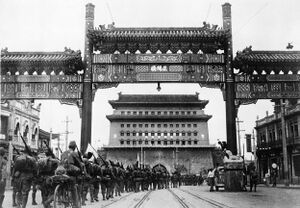
The civilian government in Tokyo tried to minimise the Army's aggression in Manchuria, and announced it was withdrawing. On the contrary, the Army completed the conquest of Manchuria, and the civilian cabinet resigned. The political parties were divided on the issue of military expansion. Prime Minister Tsuyoshi tried to negotiate with China, but was assassinated in the May 15 Incident in 1932, which ushered in an era of nationalism and militarism led by the Imperial Japanese Army and supported by other right-wing societies. The IJA's nationalism ended civilian rule in Japan until after 1945.[58]
The Army, however, was itself divided into cliques and factions with different strategic viewpoints. One faction viewed the Soviet Union as the main enemy; the other sought to build a mighty empire based in Manchuria and northern China. The Navy, while smaller and less influential, was also factionalised. Large-scale warfare, known as the Second Sino-Japanese War, began in August 1937, with naval and infantry attacks focused on Shanghai, which quickly spread to other major cities. There were numerous large-scale atrocities against Chinese civilians, such as the Nanjing massacre in December 1937, with mass murder and mass rape. By 1939 military lines had stabilised, with Japan in control of almost all of the major Chinese cities and industrial areas. A puppet government was set up.[54] In the U.S., government and public opinion—even including those who were isolationist regarding Europe—was resolutely opposed to Japan and gave strong support to China. Meanwhile, the Japanese Army fared badly in large battles with the Soviet Red Army in Mongolia at the Battles of Khalkhin Gol in summer 1939. The USSR was too powerful. Tokyo and Moscow signed a nonaggression treaty in April 1941, as the militarists turned their attention to the European colonies to the south which had urgently-needed oil fields.[59]
أمريكا اللاتينية
The United States launched minor interventions into Latin America. These included military presence in Cuba, Panama with the Panama Canal Zone, Haiti (1915–1935), Dominican Republic (1916–1924) and Nicaragua (1912–1933). The U.S. Marine Corps began to specialize in long-term military occupation of these countries.[60]
The Great Depression posed a great challenge to the region. The collapse of the world economy meant that the demand for raw materials drastically declined, undermining many of the economies of Latin America. Intellectuals and government leaders in Latin America turned their backs on the older economic policies and turned toward import substitution industrialisation. The goal was to create self-sufficient economies, which would have their own industrial sectors and large middle classes and which would be immune to the fluctuations of the global economy. Despite the potential threats to United States commercial interests, the Roosevelt administration (1933–1945) understood that the United States could not wholly oppose import substitution. Roosevelt implemented a Good Neighbour policy and allowed the nationalisation of some American companies in Latin America. Mexican President Lázaro Cárdenas nationalised American oil companies, out of which he created Pemex. Cárdenas also oversaw the redistribution of a quantity of land, fulfilling the hopes of many since the start of the Mexican Revolution. The Platt Amendment was also repealed, freeing Cuba from legal and official interference of the United States in its politics. The Second World War also brought the United States and most Latin American nations together, with Argentina the main hold out.[61]
During the interwar period, United States policy makers continued to be concerned over German influence in Latin America.[62][63] Some analysts grossly exaggerated the influence of Germans in South America even after the First World War when German influence somewhat declined.[63][64] As the influence of United States grew all-over the Americas Germany concentrated its foreign policy efforts in the Southern Cone countries where US influence was weaker and larger German communities were at place.[62]
The contrary ideals of indigenismo and hispanismo held sway among intellectuals in Spanish-speaking America during the interwar period. In Argentina the gaucho genre flourished. A rejection of "Western universalist" influences was in vogue across Latin America.[62] This last tendency was in part inspired by the translation into Spanish of the book Decline of the West in 1923.[62]
الرياضة
Sports became increasingly popular, drawing enthusiastic fans to large stadiums.[65] The International Olympic Committee (IOC) worked to encourage Olympic ideals and participation. Following the 1922 Latin American Games in Rio de Janeiro, the IOC helped to establish national Olympic committees and prepare for future competition. In Brazil, however, sporting and political rivalries slowed progress as opposing factions fought for control of international sport. The 1924 Summer Olympics in Paris and the 1928 Summer Olympics in Amsterdam had greatly increased participation from Latin American athletes.[66]
English and Scottish engineers had brought futebol (soccer) to Brazil in the late 19th century. The International Committee of the YMCA of North America and the Playground Association of America played major roles in training coaches.[67] Across the globe after 1912, the Fédération Internationale de Football Association (FIFA) played the chief role in the transformation of association football into a global game, working with national and regional organisations, and setting up the rules and customs, and establishing championships such as the World Cup.[68]

نهاية عهد
The interwar period ended in September 1939 with the German and Soviet invasion of Poland and the start of World War II.[3]
انظر أيضاً
- International relations of the Great Powers (1814–1919)
- Aftermath of World War I
- 1920s
- Jazz age
- Roaring Twenties
- 1930s
- International relations (1919–1939)
- Diplomatic history of World War I
- Diplomatic history of World War II
- Causes of World War II
- Interwar Britain
- European Civil War
- European interwar dictatorships
- Interwar United States
- Interwar Poland
- Interwar Belgium
- Second Thirty Years' War
- 1920s in Western fashion
- Great Depression
- Political history of the world
خطوط زمنية
الهامش
- ^ Simonds, Frank H. (9 November 1919). "A Year After the Armistice—The Unsettled Disputes". New-York Tribune. p. 26. Archived from the original on 9 November 2019. Retrieved 10 November 2019.
- ^ Paul Sann, The Lawless Decade Retrieved 2009-09-03 Archived 2018-04-07 at the Wayback Machine
- ^ أ ب Overy, R J (2015). The Inter-war Crisis, 1919–1939. London, New York: Routledge. ISBN 978-1-1381-379-36. OCLC 949747872.
{{cite book}}:|archive-url=requires|url=(help); Unknown parameter|author_link=ignored (help); Unknown parameter|سنة النشر الأصلية=ignored (help); Unknown parameter|طبعة=ignored (help); Unknown parameter|مسار=ignored (help) خطأ استشهاد: وسم<ref>غير صالح؛ الاسم "Overy-2016" معرف أكثر من مرة بمحتويات مختلفة. - ^ Schrader, Bärbel; Schebera, Jürgen (1988). The "Golden" Twenties: Art and Literature in the Weimar Republic. New Haven: Yale University Press. ISBN 0-300-04144-6.
- ^ Todd, Allan (2001). The Modern World. Oxford University Press. pp. 52–58. ISBN 0-19-913425-1. Archived from the original on 22 November 2019. Retrieved 19 May 2018.
- ^ Rich, Norman (2003). Great Power Diplomacy Since 1914. Boston: McGraw-Hill. pp. 70–248. ISBN 0-07-052266-9.
- ^ O'Connor, Raymond G. (1958). "The "Yardstick" and Naval Disarmament in the 1920's". The Mississippi Valley Historical Review. 45 (3): 441–463. doi:10.2307/1889320. JSTOR 1889320.
- ^ McKercher, B. J. C. (1993). "The politics of naval arms limitation in Britain in the 1920s". Diplomacy and Statecraft. 4 (3): 35–59. doi:10.1080/09592299308405895.
- ^ Blake, Jody (1999). Le Tumulte Noir: modernist art and popular entertainment in jazz-age Paris, 1900–1930. Penn State Press. ISBN 0-271-02339-2.
- ^ Duncan, Alastair (2009). Art Deco Complete: The Definitive Guide to the Decorative Arts of the 1920s and 1930s. Thames & Hudson. ISBN 978-0-500-23855-4.
- ^ Price, S (1999). "What made the twenties roar?". Scholastic Update. 131 (10): 3–18.
- ^ Maier, Charles D. (1975). Recasting Bourgeois Europe: Stabilization in France, Germany, and Italy in the Decade After World War I. Princeton University Press. ISBN 0-691-05220-4.
- ^ Gordon Martel, ed. (2011). A Companion to Europe 1900–1945. pp. 449–50. ISBN 9781444391671. Archived from the original on 19 February 2017. Retrieved 19 February 2017.
- ^ Hamish Macdonald (1998). Mussolini and Italian Fascism. Nelson Thornes. p. 20. ISBN 9780748733866. Archived from the original on 15 December 2019. Retrieved 12 May 2018.
- ^ Garrick Bailey; James Peoples (2013). Essentials of Cultural Anthropology. Cengage Learning. p. 208. ISBN 978-1285415550. Archived from the original on 19 February 2017. Retrieved 19 February 2017.
- ^ Leslie Hume (2016). The National Union of Women's Suffrage Societies 1897–1914. Routledge. p. 281. ISBN 9781317213260. Archived from the original on 19 February 2017. Retrieved 19 February 2017.
- ^ Derek Howard Aldcroft; Steven Morewood (2013). The European Economy Since 1914. Routledge. pp. 44, 46. ISBN 9780415438896. Archived from the original on 19 February 2017. Retrieved 19 February 2017.
- ^ Matera, Marc; Kent, Susan Kingsley (2017). The Global 1930s: The International Decade. Routledge. p. 192. ISBN 978-0-415-73830-9.
- ^ Payne, Stanley G. (1995). A History of Fascism, 1914–1945. Madison: University of Wisconsin Press. ISBN 0-299-14870-X.
- ^ Soucy, Robert (2015). "Fascism". Encyclopaedia Britannica. Archived from the original on 25 October 2018. Retrieved 2 December 2017.
- ^ Brown, Judith; Louis, Wm Roger, eds. (1999). The Oxford History of the British Empire: Volume IV: The Twentieth Century. pp. 1–46.
- ^ Lee, Stephen J. (1996). Aspects of British Political History, 1914–1995. p. 305. ISBN 0-415-13102-2.
- ^ Louis, William Roger (2006). Ends of British Imperialism: The Scramble for Empire, Suez and Decolonization. pp. 294–305. ISBN 1-84511-347-0.
- ^ Low, Donald Anthony; Ray, Rajat Kanta (2006). Congress and the Raj: Facets of the Indian Struggle, 1917–47. Oxford UP. ISBN 0-19-568367-6.
- ^ Sayer, Derek (1991). "British reaction to the Amritsar massacre 1919–1920". Past & Present. 131 (1): 130–64. doi:10.1093/past/131.1.130.
- ^ أ ب ت Mowat, C. L. (1968). The New Cambridge Modern History, Vol. 12: The Shifting Balance of World Forces, 1898–1945 (2nd ed.). – 25 chapters; 845 pp
- ^ McLeave, Hugh (1970). The Last Pharaoh: Farouk of Egypt. New York: McCall. ISBN 0-8415-0020-7.
- ^ De Gaury, Gerald (1961). Three Kings in Baghdad, 1921–1958. London: Hutchinson. OCLC 399044.
- ^ Bulliet, Richard (2010). The Earth and Its Peoples: A Global History. Vol. 2: Since 1500. et al. (5th ed Cengage Learning ed.). ISBN 978-1439084755. excerpt pp. 774–845
- ^ Kershaw, Ian, ed. (1990). Weimar: Why did German Democracy Fail?. New York: St. Martin's Press. ISBN 0-312-04470-4.
- ^ Weitz, Eric D. (2013). Weimar Germany: Promise and Tragedy. Princeton University Press. ISBN 978-0-691-15796-2.
- ^ Elz, Wolfgang (2009). "Foreign policy". In McElligott, Anthony (ed.). Weimar Germany. Oxford University Press. pp. 50–77. ISBN 978-0-19-928007-0.
- ^ Richard J. Evans, The Coming of the Third Reich (2005) and Evans, The Third Reich in Power (2006).
- ^ Kershaw, Ian, ed. (1990). Weimar: Why did German Democracy Fail?. New York: St. Martin's Press. ISBN 0-312-04470-4.
- ^ Weitz, Eric D. (2013). Weimar Germany: Promise and Tragedy. Princeton University Press. ISBN 978-0-691-15796-2.
- ^ Elz, Wolfgang (2009). "Foreign policy". In McElligott, Anthony (ed.). Weimar Germany. Oxford University Press. pp. 50–77. ISBN 978-0-19-928007-0.
- ^ Lowe, pp. 191–199[استشهاد ناقص]
- ^ أ ب ت Smith, Dennis Mack (1981). Mussolini. London: Weidenfeld and Nicolson. p. 170. ISBN 0-297-78005-0.
- ^ أ ب ت ث Salerno, Reynolds Mathewson (2002). Vital Crossroads: Mediterranean Origins of the Second World War, 1935–1940. Cornell University Press. pp. 105–106. ISBN 0-8014-3772-5.
- ^ أ ب Bideleux, Robert; Jeffries, Ian (1998). A History of Eastern Europe: Crisis and Change. London: Routledge. p. 467. ISBN 0-415-16111-8.
- ^ Millett, Allan R.; Murray, Williamson (2010). Military Effectiveness. Vol. 2 (New ed.). New York: Cambridge University Press. p. 184.
- ^ أ ب Burgwyn, James H. (1997). Italian Foreign Policy in the Interwar Period, 1918–1940. Praeger. p. 68. ISBN 978-0-275-94877-1. Archived from the original on 9 December 2019. Retrieved 24 May 2017.
- ^ أ ب Whealey, Robert H. (2005). Hitler And Spain: The Nazi Role In The Spanish Civil War, 1936–1939 (Paperback ed.). Lexington: University Press of Kentucky. p. 11. ISBN 0-8131-9139-4.
- ^ Balfour, Sebastian; Preston, Paul (1999). Spain and the Great Powers in the Twentieth Century. London: Routledge. p. 152. ISBN 0-415-18078-3.
- ^ Bosworth, R. J. B. (2009). The Oxford Handbook of Fascism. Oxford: Oxford University Press. p. 246.
- ^ Mearsheimer, John J. (2003). The Tragedy of Great Power Politics. W. W. Norton & Company. ISBN 0-393-32396-X.
- ^ The Road to Oran: Anglo-Franch Naval Relations, September 1939 – July 1940. p. 24.
- ^ أ ب Salerno, Reynolds Mathewson (2002). Vital Crossroads: Mediterranean Origins of the Second World War, 1935–1940. Cornell University. pp. 82–83. ISBN 0-8014-3772-5.
- ^ أ ب "French Army breaks a one-day strike and stands on guard against a land-hungry Italy". Life. 19 December 1938. p. 23.
- ^ Tomes, Jason (2001). "The Throne of Zog". History Today. 51 (9): 45–51.
- ^ Fischer, Bernd J. (1999). Albania at War, 1939–1945. Purdue UP. ISBN 1-55753-141-2.
- ^ Hoisington, William A. Jr. (1971). "The Struggle for Economic Influence in Southeastern Europe: The French Failure in Romania, 1940". Journal of Modern History. 43 (3): 468–482. doi:10.1086/240652. JSTOR 1878564. S2CID 144182598.
- ^ أ ب Gerwarth, Robert (2007). Twisted Paths: Europe 1914–1945. Oxford University Press. pp. 242–261. ISBN 978-0-1992-8185-5. Archived from the original on 17 April 2021. Retrieved 14 October 2020.
- ^ أ ب ت Fairbank, John K.; Reischauer, Edwin O.; Craig, Albert M. (1965). East Asia: The Modern Transformation. Boston: Houghton Mifflin. pp. 501–4. OCLC 13613258.
- ^ Paul W. Doerr (1998). British Foreign Policy, 1919–1939. p. 120. ISBN 9780719046728. Archived from the original on 17 November 2019. Retrieved 16 March 2018.
- ^ Chang, David Wen-wei (2003). "The Western Powers and Japan's Aggression in China: The League of Nations and 'The Lytton Report'". American Journal of Chinese Studies. 10 (1): 43–63. JSTOR 44288722.
- ^ Yamamuro, Shin'ichi (2006). Manchuria under Japanese Dominion. U. of Pennsylvania Press; online "Review". Journal of Japanese Studies. 34 (1): 109–114. 2007. doi:10.1353/jjs.2008.0027. S2CID 146638943.
- ^ Huffman, James L. (2013). Modern Japan: An Encyclopedia of History, Culture, and Nationalism. p. 143. ISBN 978-1-135-63490-2. Archived from the original on 13 December 2019. Retrieved 16 March 2018.
- ^ Feis, Herbert (1960). The Road to Pearl Harbor: The Coming of the War Between the United States and Japan. Princeton University Press. pp. 8–150. OCLC 394264.
- ^ Lester D. Langley, The Banana Wars: United States Intervention in the Caribbean, 1898–1934 (2001)
- ^ Bulmer-Thomas, Victor (2003). The Economic History of Latin America since Independence (2nd ed.). Cambridge University Press. pp. 189–231. ISBN 0-521-53274-4.
- ^ أ ب ت ث Goebel, Michael (2009). "Decentring the German Spirit: The Weimar Republic's Cultural Relations with Latin America". Journal of Contemporary History. 44 (2): 221–245. doi:10.1177/0022009408101249. S2CID 145309305.
- ^ أ ب Penny, H. Glenn (2017). "Material Connections: German Schools, Things, and Soft Power in Argentina and Chile from the 1880s through the Interwar Period". Comparative Studies in Society and History. 59 (3): 519–549. doi:10.1017/S0010417517000159. S2CID 149372568.
- ^ Sanhueza, Carlos (2011). "El debate sobre "el embrujamiento alemán" y el papel de la ciencia alemana hacia fines del siglo XIX en Chile" (PDF). Ideas viajeras y sus objetos. El intercambio científico entre Alemania y América austral. Madrid–Frankfurt am Main: Iberoamericana–Vervuert (in الإسبانية). pp. 29–40.
- ^ Sheinin, David M. K., ed. (2015). Sports Culture in Latin American History. University of Pittsburgh Press. ISBN 978-0-8229-6337-0.
- ^ Torres, Cesar R. (2006). "The Latin American 'Olympic Explosion' of the 1920s: causes and consequences". International Journal of the History of Sport. 23 (7): 1088–111. doi:10.1080/09523360600832320. S2CID 144085742.
- ^ Guedes, Claudia (2011). "'Changing the cultural landscape': English engineers, American missionaries, and the YMCA bring sports to Brazil–the 1870s to the 1930s". International Journal of the History of Sport. 28 (17): 2594–608. doi:10.1080/09523367.2011.627200. S2CID 161584922.
- ^ Dietschy, Paul (2013). "Making football global? FIFA, Europe, and the non-European football world, 1912–74". Journal of Global History. 8 (2): 279–298. doi:10.1017/S1740022813000223. S2CID 162747279.
وصلات خارجية
- wide range of diplomatic documents from many countries, Mount Holyoke College edition
- "Britain 1919 to the present" Several large collections of primary sources and illustrations
- Primary source documents
قالب:Great Depression قالب:United States–Commonwealth of Nations recessions
- صفحات تستخدم خطا زمنيا
- CS1: Julian–Gregorian uncertainty
- CS1 errors: unsupported parameter
- CS1 errors: archive-url
- Articles with incomplete citations from September 2020
- All articles with incomplete citations
- CS1 الإسبانية-language sources (es)
- Short description is different from Wikidata
- Articles with hatnote templates targeting a nonexistent page
- Missing redirects
- صفحات بها وصلات إنترويكي
- مقالات ذات عبارات بحاجة لمصادر
- Articles to be expanded from May 2022
- All articles to be expanded
- Articles with empty sections from May 2022
- All articles with empty sections
- Interwar period
- Aftermath of World War I
- Former countries of the interwar period
- Chronology of World War II
- Periodization
